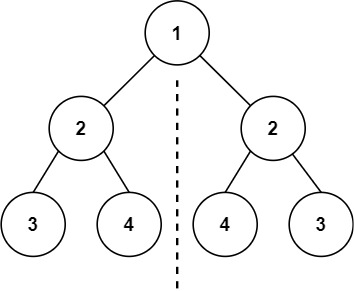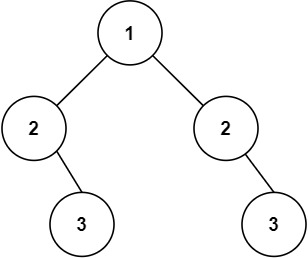Q:
Given the root of a binary tree, check whether it is a mirror of itself (i.e., symmetric around its center).
Example 1:

Input: root = [1,2,2,3,4,4,3] Output: true
Example 2:

Input: root = [1,2,2,null,3,null,3] Output: false
Constraints:
- The number of nodes in the tree is in the range
[1, 1000]. -100 <= Node.val <= 100
A:
iterative 方法: 左右两边各自写成一个stack形式。然后一起比较
--------------------------------------------------------------------------------/*** Definition for a binary tree node.* struct TreeNode {* int val;* TreeNode *left;* TreeNode *right;* TreeNode() : val(0), left(nullptr), right(nullptr) {}* TreeNode(int x) : val(x), left(nullptr), right(nullptr) {}* TreeNode(int x, TreeNode *left, TreeNode *right) : val(x), left(left),* right(right) {}* };*/class Solution {public:bool isSymmetric(TreeNode* root) {if (!root)return true;stack<TreeNode*> SL;SL.push(root->left); // save left, remember to save nullptrstack<TreeNode*> SR;SR.push(root->right);while (!SL.empty()) {if (SR.empty())return false;auto l = SL.top();auto r = SR.top();SL.pop();SR.pop();if (!l && !r) {continue;} else if (!l || !r) {return false;} else {if (l->val != r->val) {return false;}SL.push(l->left);SL.push(l->right);SR.push(r->right);SR.push(r->left);}}return SR.empty();}};Mistakes:必须是右边的先加右子树,而不能是先左后又,然后倒着找。
这个是recursive 方法
class Solution {public:bool isSymmetric(TreeNode* root) {if(!root)return true;return helper(root->left, root->right);}private:bool helper(TreeNode* rootL, TreeNode* rootR){if(rootL == nullptr && rootR == nullptr)return true;if(rootL == nullptr || rootR == nullptr)return false;return rootL->val == rootR->val && helper(rootL->left, rootR->right) && helper(rootL->right, rootR->left);}};
------------------------------第二遍, 想只是给一个flag,标记先左还是先右, 这种最终证明,是不对的-------- 错误的关键问题在于, 题目本身只要求 对称, 就是对着中心一条轴对称即可。 那样左右扭来扭曲,就变得很奇怪的了。
---------但是,可以给出左右两个queue, 来对比每一层的结果, 也就是说,root的左边,一直先左子树。 root的右边,一直是先右子树。 !!!-----------
public class Solution {
public boolean isSymmetric(TreeNode root) {
// in-order tree traversal
ArrayList<Integer> al = new ArrayList<Integer>();
inOrder(root, al, true);
int i = 0, j = al.size() - 1;
while (i < j) {
if (al.get(i++) != al.get(j--))
return false;
}
return true;
}
void inOrder(TreeNode root, ArrayList<Integer> al, boolean leftFirst) {
if (root == null)
return;
if (leftFirst) {
if (root.left != null)
inOrder(root.left, al, false);
al.add(root.val);
if (root.right != null)
inOrder(root.right, al, false);
} else {
if (root.right != null)
inOrder(root.right, al, true);
al.add(root.val);
if (root.left != null)
inOrder(root.left, al, true);
}
}
}
哎, 以后过了12点,就不干活了。 TNND, 效率不行,还耽误睡觉。
好不容易搞出来了吧, 还TMD,净是在一些SB的小错误上浪费时间,没有意义啊。 干个啥呀??? Tiger
以后状态不好的时候,不用coding, 浪费时间, 完全就是在浪费时间!!!!!!!!!!!!!!!
去玩儿吧, 去运动, 去看看小说,也行啊。 搞得心情不好,净在些拼写错误上啊,什么的浪费时间, 哎, ~~~~~~~~~~
No comments:
Post a Comment